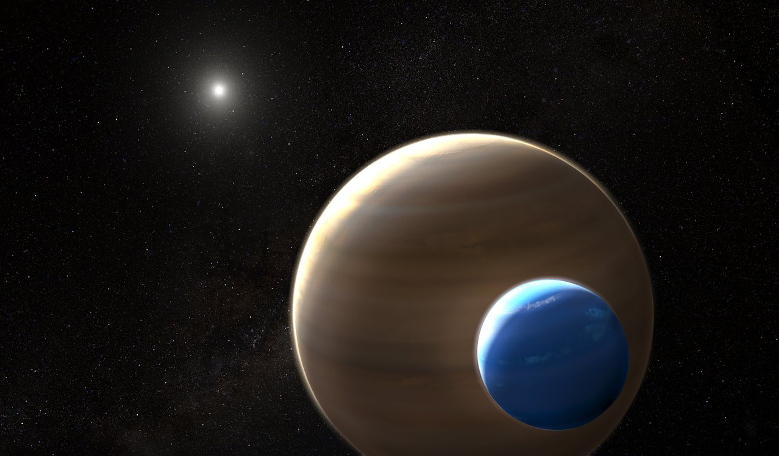In a stellar system 8000 light-years from Earth, astronomers have found the first compelling evidence for a Neptune-sized moon orbiting a Jupiter-sized planet.
Detections of exoplanets come thick and fast nowadays as a multitude of telescopes both on the ground or in orbit, are programmed to constantly scan the skies for the myriad of exoworlds we are now accustomed to finding. However, although it might now feel commonplace to find exotic exoworlds, detecting one is no walk in the park.
To find an exoplanet, astronomers rely on spotting the tiniest dips of light as a planet passes in front of its host star (the transit method) – which themselves are only small pinpricks of light when viewed with even the largest telescopes. Or they look for a minuscule wobble in the motion of a star, caused by the gravitational tug of its orbiting planet (the radial method). Imagine then, the work that needs doing in order to find a moon orbiting a planet that is itself orbiting around an average-sized star in a far-off system thousands of light years away.
It helps, if the moon your searching for is rather big too; say on the scale of a medium to large planet. And this is the size that the candidate moon, called Kepler-1625b-i, is. Kepler-1625b-i is roughly the size of our own ice giant Neptune. Despite its size, the mass of Kepler-1625b-i is estimated to be only 1.5 percent of the mass of its companion planet (Kepler-1625b). A mass ratio that is similar to that of Earth and the Moon.
This is also not the first time that Kepler-1625b-i has been observed. Last year, tentative hints of the same exomoon orbiting at a distance of 20 planetary radii around its host planet was announced. Kepler-1625b is a Jovian-sized gas giant and although the data looked compelling enough, scientists were not able to say definitively that it was a bona-fide detection.
Fast forward a year and throw in a mix of data from the Hubble Space Telescope and older data from the Kepler Space Telescope and the results look a lot more promising.
This time two scientists, Alex Teachey, a graduate student who led the study and David Kipping, both from Columbia University in New York, US detected a second and much smaller decrease in the star’s brightness approximately 3.5 hours after the exomoon’s planet (Kepler-1625b) made its journey around its host star; a feature that is consistent with the effect of a moon trailing the planet.
In addition, as a planet and its moon orbit a common centre of gravity, it causes the planet to wobble away from its predicted location. This shift in the planet’s predicted transit was also picked up by Hubble, adding more weight to the theory that an exomoon was behind the changes.
“We saw little deviations and wobbles in the light curve that caught our attention,” said Kipping. “It was definitely a shocking moment to see that light curve — my heart started beating a little faster and I just kept looking at that signature,”
Although further observations by Hubble are needed to fully confirm the existence of Kepler-1625b-i, as such gargantuan moons are unknown in our own Solar System, if it turns out to be real then it may yield new insights into the development of planetary systems and may cause astronomers to revisit theories of how moons form, said Teachey.











